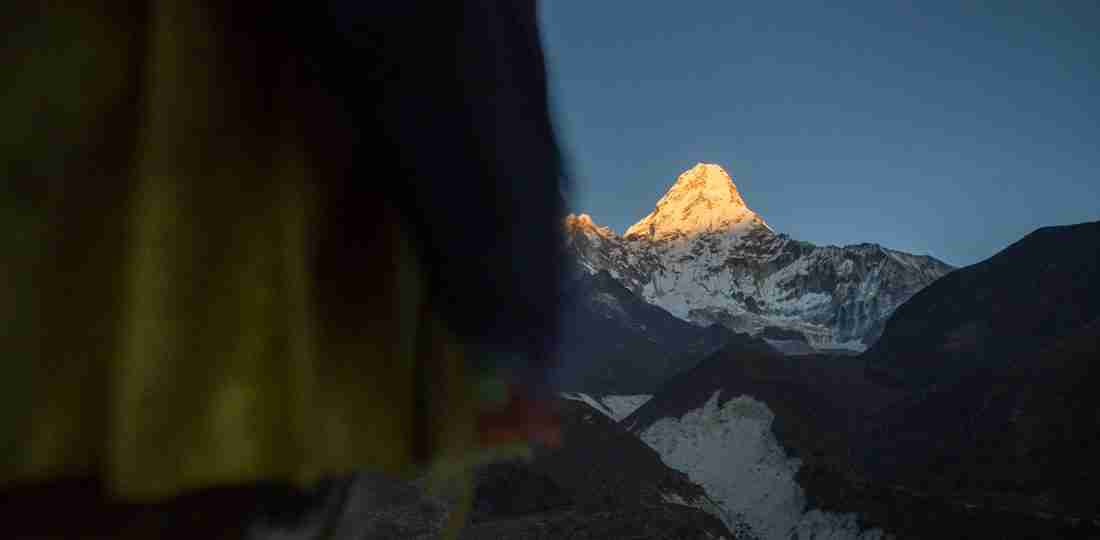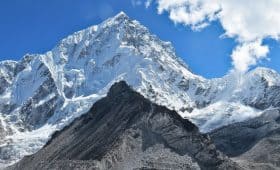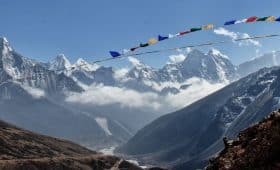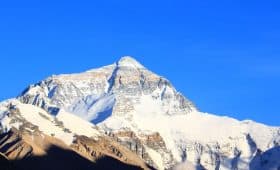The idea of walking through the high altitude trail towards the foothills of the world’s highest mountain might sound frightening.
But the Everest base camp trek difficulty is not as intense as most people would have expected.
The Everest base camp trek will take you on a long journey to the remote trails of the Khumbu region.
The daunting task of crossing the suspension bridge above the vast Dudh Koshi river is among the first adventures in this legendary trek. ‘
You ought to take high-altitude uphill climbs and walk through rugged terrains.
The altitude throughout the treks will be above 2500 meters, with Kala Patthar’s 5545 meters (that’s 18,192 feet) altitude being the highest.
A total of 130 kilometers (or 80 miles) worth of walking is required to complete this trek.
It might take anywhere from 8 to 12 days to complete this journey, depending on the itinerary you choose.
Considering these factors, the Everest Base Camp trek difficulty level is a “little challenging.”
As per trekking difficulty levels, the Mount Everest Base camp trek difficulty is at level three, not the toughest trek in Nepal but still challenging.
Let us analyze this further and find out more about the Everest base camp trek difficulty.
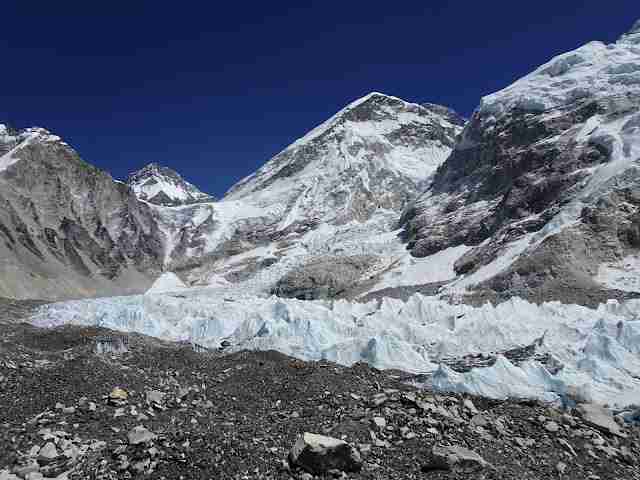
Table of Contents
Everest Base Camp trek difficulty level
The Nepali Himalayan trekking trail’s difficulty is divided into four different levels.
The difficulty level usually depends on the distance you travel, the altitude you gain and the total number of trekking days.
Based on these variables, the treks are separated into one of these four levels.
The fourth grade being the toughest trek and the first grade being the easiest.
Let us go into detail about these distinctions and analyze the Everest base camp trek difficulty in detail.
Division of trekking difficulty levels
Grade one level difficulty – They are easy and beginner friendly treks and usually occur below 3000 meters.
The hikes are roughly about 4 to 6 days long on such trips.
Grade two level difficulty – These treks occur between the altitude of 3000 meters and 4500 meters.
It may take 7 to 10 days to complete such treks.
Grade three level difficulty – These are treks that occur between 4500 meters and 5600 meters above sea level.
They mostly take above 10 days to a fortnight to complete.
Grade four level difficulty – These treks occur above 5600 meters and are the most challenging treks in Nepal.
They usually take more than a fortnight to complete.

On What level does the Everest Base Camp difficulty lie?
The Everest Base Camp trek does not have a rigid itinerary, route or travel days.
In fact, most trekking journeys in Nepal do not have such trails.
So, to analyze the Mount Everest Base Camp trek difficulty level, we need to further examine its variables.
The highest point we travel on this trek is at Kala Patthar, which has an altitude of 5545 meters.
However, most of the places that we visit on this trek lie below the altitude of 5000 meters.
So the average altitude hiked in the Everest Base camp trek would fit in the category of between 4000 meters and 5600 meters.
The Everest Base camp, based on varied itineraries, takes around 8 days to 12 days to complete.
Considering the altitude traveled and the number of days taken, the Everest Base Camp trek difficulty level lies at grade three.
This means, for most trekkers, the Everest Base Camp trek can not be considered a piece of cake.
Although it is quite challenging, it does not fall among the toughest treks of Nepal.
There are various factors aiding the Everest Base Camp trek difficulty level.
We take you through all these factors and provide tips of Everest Base Camp Trek to mitigate this here.
So we recommend you to stick with us!
Want more information? Send us your query, and our experts will get back to you within 24 hrs.
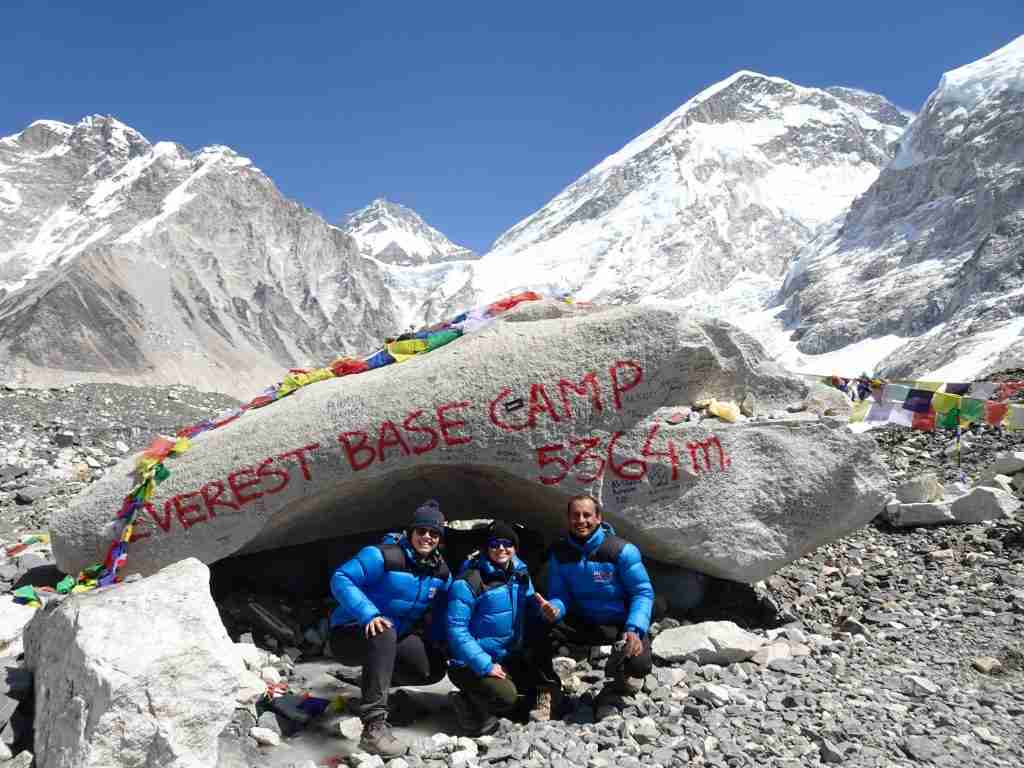
Challenges you might face in the Everest Base Camp trek
Altitude sickness
Altitude sickness is a series of illnesses that show symptoms like dizziness, vomiting, headache, blurred vision, tingling sensation in your fingertips, etc.
These symptoms show that you have gained a lot of altitude, especially while trekking.
It happens when the brain does not receive enough oxygen saturation.
It is common knowledge that the oxygen saturation levels in the air decrease in higher places.
The least dangerous types of altitude sicknesses occur above 3500 meters of altitude.
The EBC trek takes you above 5500 meters, so altitude sickness is a probable risk aiding the Everest Base Camp trek difficulty.
There are three stages to altitude sickness; AMS, HAPE, and HACE.
These stages occur when one worsens and turns into another.
For example, AMS, or Acute Mountain Sickness, is the least-threatening altitude sickness.
It has mild symptoms like nausea, vomiting, headaches, etc. AMS can be treated easily with a day or two of rest, but if not treated, it turns into HAPE.
HAPE, also called High Altitude Pulmonary Edema, is the secretion of extra fluid in the lungs.
HAPE needs a little more care than AMS, you might have to return from your trip if you get HAPE. If HAPE is not treated, it will fester into HACE.
HACE is the worst form of HAPE, called High-altitude Cerebral Edema.
This occurs when your brain secretes excess liquid.
HACE is a deadly occurrence and needs immediate medical attention.
If it isn’t treated well and on time, the victim might lapse into a coma or even die.
Hence, the altitude-sickness problems, although simple, might bring deadly consequences.
But if you treat them right or take precautions, you can easily mitigate them.
Prevention and treatment for altitude sickness
The best way to be safe from altitude sickness is to ensure it doesn’t happen.
You need to focus on prevention rather than medical care after its occurrence.
You have to allocate resting days on your itinerary to accommodate your body in higher altitudes.
Do not take caffeine or alcohol on your journey, as they aid in altitude sickness by dehydrating your body.
Also, stay away from smoking!
You need to be hydrated well to reduce the chances of altitude sickness.
If mild symptoms of AMS occur, you need to take rest and well hydrate yourself.
Take Diamox tablets with you as they help with symptoms like nausea and vomiting.
If, unfortunately, HAPE and HACE occur to you or people in your team, seek help.
You need to immediately take the sick person to a lower altitude or a nearby health center.
You might need helicopter rescue if you are in a very remote area.
So, research and keep in contact with agencies providing such services to you.
Travel insurance might be handy in these cases as they pay for such unfortunate incidents.
If you are traveling with a local tour operator, talk to your guide and they can get the required assistance talking to their office in Kathmandu
The Everest Base Camp weather like any other high altitude mountain is very unpredictable.
A bright sunny sky might turn into a gloomy dark sky within minutes.
Chances of strong winds, which can be classified as hurricanes, can occur at any time.
Such dangerous and sporadic weather occurrences are a great danger.
The snowfalls and rainfall of the Everest region make the trails very slippery.
It increases the chances of accidents and falls during trekking. During summer and winter, the weather is at extremes.
The summer days make up for warm weather, making the trek sweaty and exhausting.
On the other hand, winter treks are very cold and require much preparation to keep yourself warm.
Snowstorms and hurricanes in winter and monsoons increase the chances of avalanches around the Everest Base Camp area.
Prevention of climate and weather-related challenges
The only way to be safe from Everest’s scary sporadic weather is to avoid off-seasonal treks without proper preparation.
If you do the Everest Base Camp trek during autumn or spring, these risks will be minimized.
The trails will be dry and very easy to trek. There are little to no risks of accidents or falls while walking.
The chances of rainfall or snowfall are minimal during autumn and spring season, making your trek more convenient.
The climate will also be temperate without much heat or extreme cold.
The likelihood of health issues due to extreme temperature also subsides due to this.
Remote, rugged trails
The trekking to Everest Base camp requires you to be resilient and comfortable in any environment.
You have to trek to very remote places with very scarce resources. So you need to expect a trip that is far from luxurious.
Teahouses are prime modes of accommodation and meals in the Everest Base Camp trails.
Everest Base Camp Trek accommodation provide the bare minimum amenities to keep you going for the trek.
The places give you a shared twin bedroom with a communal dining room and toilets.
The beds are adequate, with mattresses, bedsheets, pillows, and blankets.
But they cannot be washed after every use in remote Himalayan trails. So you need to bring your sleeping bags for proper hygiene.
The toilets in these teahouses will be the squatting kind, which you might not be familiar with. They do not have toilet paper or bidets, so you need to bring the necessary items yourself.
You will also not get running hot water in the bathrooms.
If you have to get them, the tea houses will manage to heat water in firewood and give it to you in a bucket.
You might not be used to putting so much effort into such daily activities.
So, this might make up for some discomfort during your Everest Base Camp trek.
It is unlikely that the teahouses will provide wifi or internet services.
Even to use electricity services you might have to pay extra. Prepare for these minute necessities by buying a data package and carrying power banks.
These days there are some companies offering wi-fi on the Everest trail but don’t rely 100% on them as their services regularly interrupt.
The meals that these teahouses provide will be very basic. The resources in these tea houses are very scarce due to a lack of proper transportation.
So you will not get a high range of options for your meal options. The staple meals of Nepali people – daal, bhaat, and tarkari are available.
This meal is a combination of rice with lentils and vegetable curry. You might also get chapati or Tibetan bread in the meal.
The food on EBC trek will, although very fundamental, will be very satiating. They will be calorically dense enough to fuel you throughout your treks.
If you are not acquainted with Nepali staples and are looking for other options, you won’t get them.
The teahouses also have limited choices for your food preference.
Meaning they might offer you vegetarian-friendly food, but the tea houses cannot fulfill all your special requirements.
Ensure you research these things before heading for the treks. Either cancel your plans if it is impossible for you to make any adjustments in your dietary requirements.
Additional advice, travel with a group to make treks to remote areas more fun.
It is always enjoyable when you have friends to accompany you on long walks.
If you are feeling difficult to adjust to the trek, you will have a support system.
Your friends will have discomforts similar to you, so you will have “the satisfaction” of not being alone.
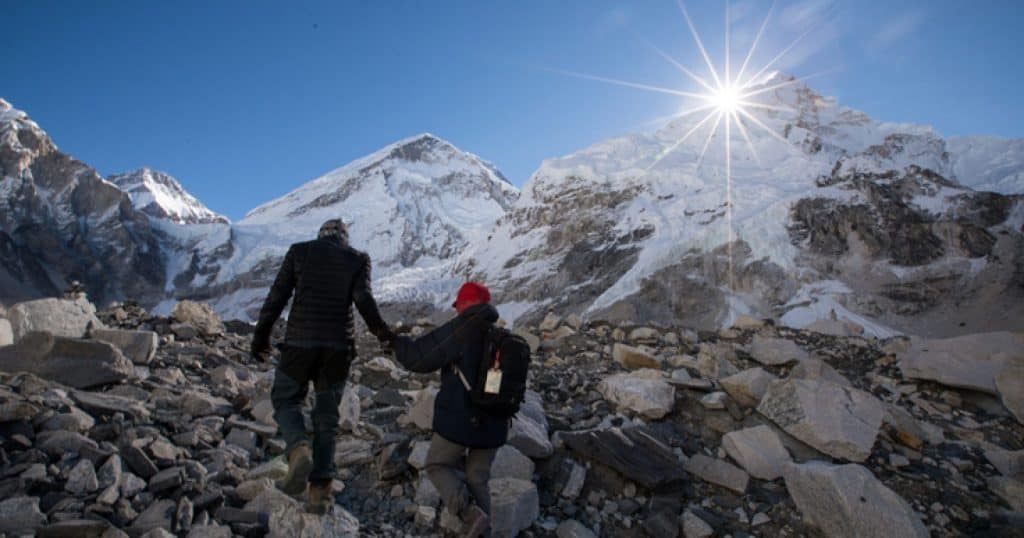
Long exhausting walks
You need to walk for many days for a long duration during the Everest Base Camp treks.
A day’s trek will take, at a minimum, more than 4 hours.
You walk 65 kilometers to reach the base camp and 65 kilometers to return from it.
If you account for visiting nearby destinations like Kala Patthar, Nagartsang Peak etc, the distance only increases.
The trek will take around 8 to 12 days, depending on the route and itinerary.
You have to carry your heavy luggage to every stop of the day.
You will barely get a day or two of rest from your daily hikes. Such a schedule will exhaust you physically and, in some cases, mentally too.
You have to prepare yourself for such a tiring routine for this trek.
Build your stamina; start working out a few months before the trek to prepare yourself.
Research various challenges and aspects of this trek to prepare yourself for the challenges.
If you face risks brought about by these treks unprepared, it might cause you a lot of anxiety.
Make peace with what you might have to do before heading for this trek.
You can make the trek a tad bit easier by hiring guide and porter in your EBC trek as well.
Professional guides make your trek easier by teaching you about the trek and it is safer to walk with professional.
They have learned about the trekking trails by heart and can make your trip comfortable.
They will teach you about the historical, natural, and cultural significance of the area. It will make your trek more interesting.
They will also help you connect with the local people in case of language barriers.
The hired porters will carry your heavy luggage and make your long walks more comfortable.
Porters in the Himalayan trails usually carry 20 kg of luggage every day.
They will also be a great company to your crew of trekking team.
Pack your bag carefully, don’t let the backpack drag you back.
Check our packing list for Everest base camp trek article if you need help with gear.

Minor fender benders
Strain, sprains, and blisters
Exhausting your legs for a long time will surely cause some damage to them.
Strains and sprains of the leg muscles due to long hikes and uphill climbs are very probable.
Strains are muscle tears, and sprains are tears in ligaments. Both these could occur due to falls, trips, or sudden twists in body parts.
Similarly, blisters are injuries that occur on the skin that form swelling with liquid secretion in it.
Blisters on the feet occur a lot during a long trekking journey, to avoid that wear break-in shoes
You can prevent these minor injuries by exercising caution in your hikes.
If your trails have become slippery or muddy, walk very carefully. Wear very comfortable hiking shoes when you hike.
Bring in comfortable, appropriate hiking gear to make your walks easier.
In case you do injure yourself with strain, sprains,and blisters, treat them with ointments.
Pain-relieving ointments are essential for a long trekking journey.
You can also treat muscle injuries by submerging the injured part in a hot water bath.
Insect bites, pests
The remote Khumbu trails will for sure introduce you to a variety of insects and pests.
Although not all of them might be life-threatening, they will still be a hassle.
Carry insect-repellent creams and wear full-sleeved clothes during your walks to avoid insects.
Avoid traveling during summer or monsoon, as insects, pests, and venomous animals lurk this time.
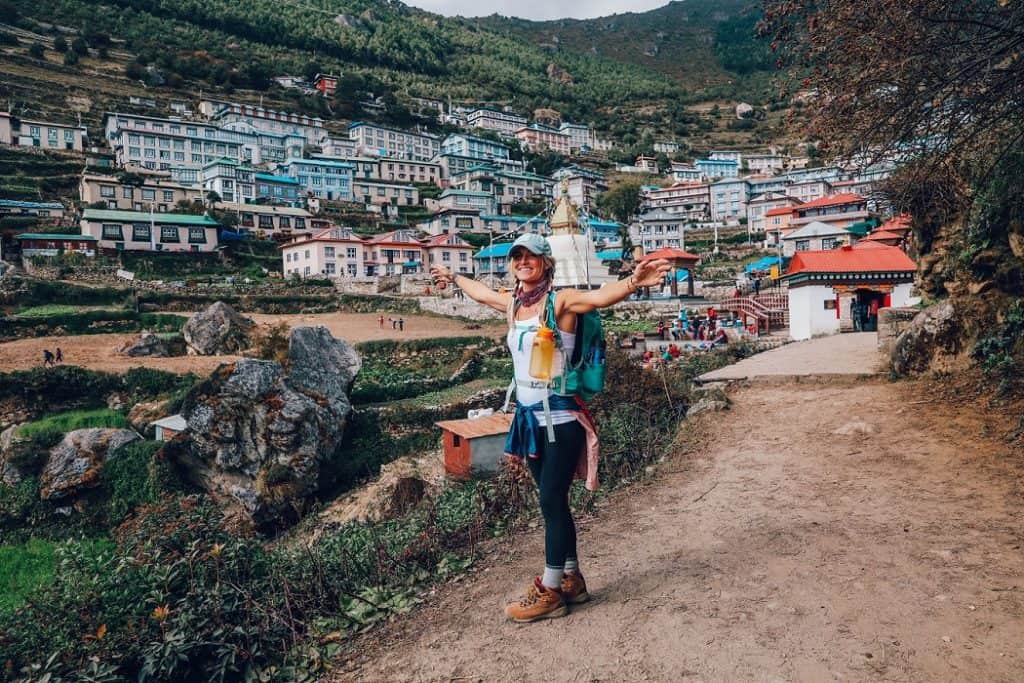
Frequently Asked Questions about Everest base camp trek difficulty
Is it difficult to trek to Everest Base Camp?
Trekking to the Everest Base Camp requires a certain level of effort.
Your difficulty level depends upon your experience level, time of trek, itinerary, route, etc.
For most, the difficulty of Everest Base Camp trek persists, but it is not life-threatening.
Can a beginner do the Everest Base Camp trek?
There are many challenges to the Everest Base Camp trek, which might be intimidating to beginners.
But with proper preparation and good physical fitness, beginners can definitely do the Everest Base Camp trek.
Which month is best for Everest Base Camp Trek?
The seasons of spring and autumn are the best time to trek Everest Base Camp.
To be precise, March to May in spring and September to November in autumn.
What is the highest altitude of the Everest Base Camp trek?
The highest altitude of the Everest Base Camp trek is at the Kala Patthar viewpoint.
Kalapatthar lies at 5,545 meters (18,192 feet) above sea level.
Is Everest Base Camp Trek crowded?
The Everest Base Camp trekking trails are crowded during peak trekking seasons.
But during other times of the year, the trails are relatively quiet.
Does snowfall occur in the Everest Base Camp trek?
Snowfall is probable during the winter months, December to February, on the Everest trails.
Everest Base Camp Trek in December is an ideal time to trek if you want to have an overall great experience with moderate temperatures compared to January and February.
You’ll get to experience some light snowfall while enjoying great views as you hike from Lukla to Everest Base Camp.
The mountain ranges are fully covered in snow, even in the early spring months.
Final Say
As Everest base camp trek is moderate to difficult, you should plan the trek with precaution.
Prepare the essentials for your trek beforehand and take the instructions we have given here as a guideline to make your trek safer and more fun.
If you wish for a safer, easier trek with less mental stress or planning, you should try trekking with us.
We at Mosaic Adventure provide you with a myriad of options for the Everest Base Camp trek.
If you are looking for Everest Base Camp best company then look no further.
We will manage your guide, porter, permits, itinerary, transportation, accommodation, etc.
Our professional, licensed, well English-speaking guide will help you throughout the route in every situation.
Contact us at Mosaic Adventure for further info or to book your trek to Everest Base Camp.
Want more information? Send us your query, and our experts will get back to you within 24 hrs.
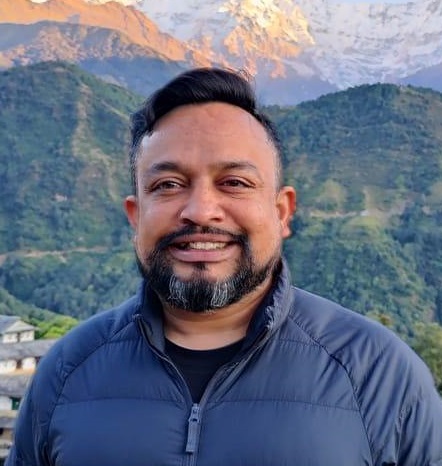
Raj is the co-founder of Mosaic Adventure who have immense knowledge of all the trail throughout Nepal. Working on the trekking industry for more than three decades Raj knows the country like back of his hands. If you need more information or help to plan any trips to Nepal, feel free to get in touch with Raj through his email [email protected] or whatsapp him on +9779851090836.

